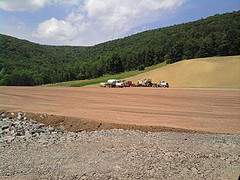New website provides guidance on Marcellus Shale development
live.psu.edu/story/59159#nw69
Friday, April 13, 2012

The 'Marcellus Shale Electronic Field Guide' provides information about mitigating landscape changes as a result of natural-gas development, such as the well-pad construction pictured here.
UNIVERSITY PARK, Pa. — A new website developed by Penn State’s College of Agricultural Sciences and Penn State Extension offers assistance in land management at all stages of shale-gas infrastructure development.
The “Marcellus Shale Electronic Field Guide” is an unbiased manual aimed at presenting the best possible options in Marcellus Shale development for Pennsylvania’s future.
“The guide provides a comprehensive overview of how landscapes change during shale-gas development and offers ways throughout the process to minimize adverse effects while maximizing long-term site restoration success,” said Patrick Drohan, assistant professor of pedology and one of the website’s lead authors.
The guide’s sections reflect the questions asked most frequently by landowners and managers and by gas-industry employees.
The field guide introduces ecological concepts relevant to shale-gas development, including habitat fragmentation and restoration and basic wildlife science. It includes sections on predevelopment issues, such as effects of shale-gas development on agriculture and forestland, control of site activity, soil erosion and compaction, and planning for spills, accidents and invasive species control.
Restoration of shale-gas development sites is explored through pages on setting goals for restoration, landscape reconstruction, revegetation options, and restoring or creating wildlife habitat. The site includes detailed analyses of important wildlife species in Pennsylvania: wild turkey, ruffed grouse and white-tailed deer, with more featured species to come.
Landowners looking for general guidance on leasing provisions may benefit from sample leases and a section on best management practices.
The field guide also includes an image gallery and a public forum in which registered users can ask questions and receive feedback from those with on-the-ground experience.
“Exploration and development of natural gas within the Marcellus Shale formation is occurring at an accelerating rate across much of Pennsylvania and may produce large-scale ecological change,” said Margaret Brittingham, professor of wildlife resources and website co-author.
“There is a critical need among public and private landowners for information on how to develop drilling sites and their associated infrastructure so as to minimize ecological damage and allow restoration of sites to predrilling conditions,” she said. “We hope this website helps to fill that need.”
The website is based on work supported by the Heinz Endowments and was designed by Penn State’s Center for Environmental Informatics. Any opinions, findings, conclusions or recommendations expressed in the field guide are those of the authors and do not necessarily reflect the view of the sponsor.
The website, which is also accessible from smart phones and similar devices, can be viewed at http://marcellusfieldguide.org/index.php

Right here is the right website for anybody who really wants to find out about this topic.
You know a whole lot its almost tough to argue with you (not that
I personally would want to…HaHa). You certainly put a brand new spin on a subject that’s been discussed for decades. Wonderful stuff, just excellent!streetdirectory